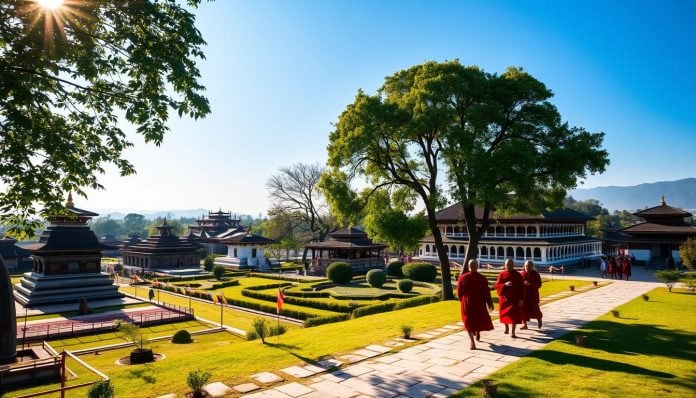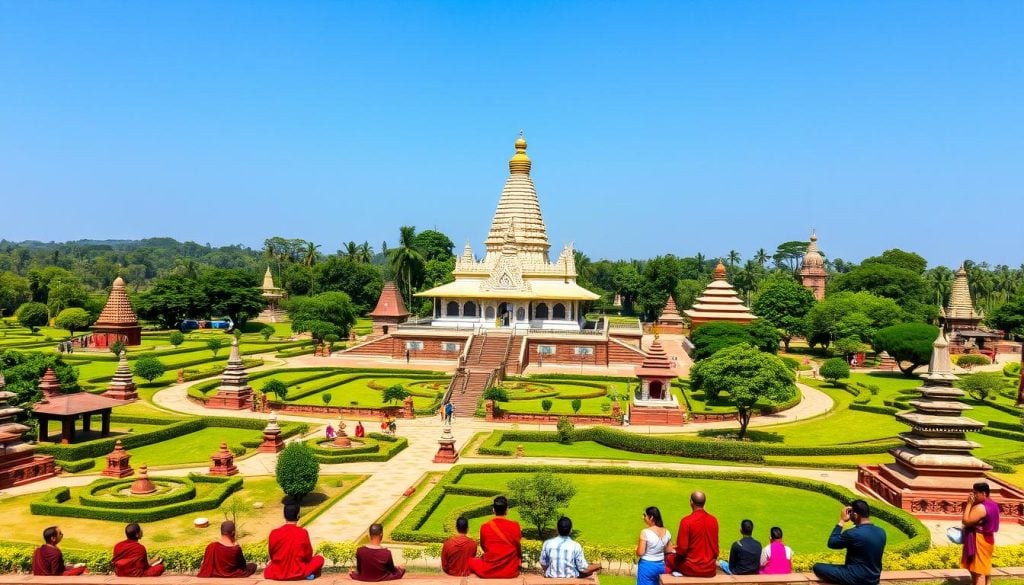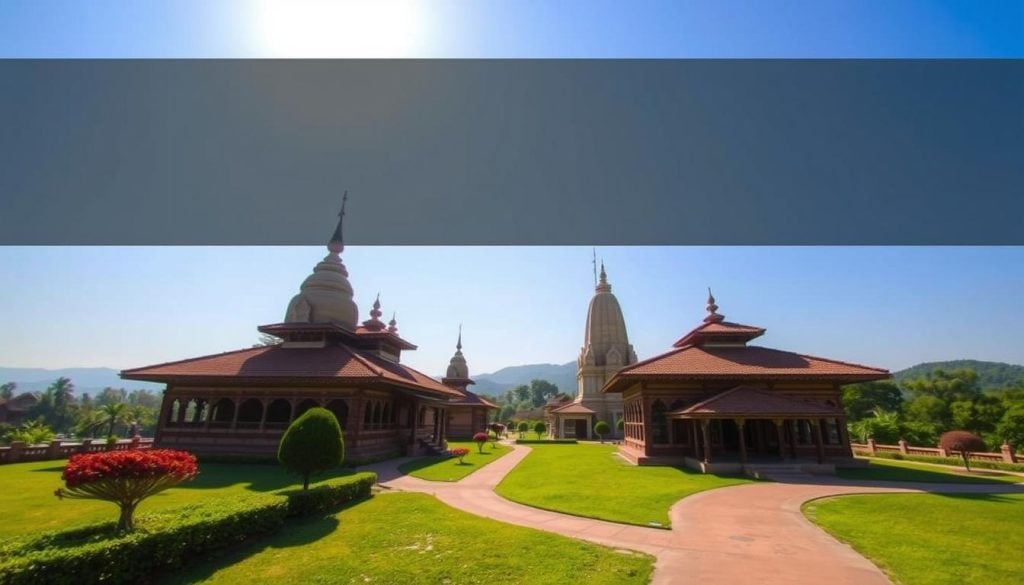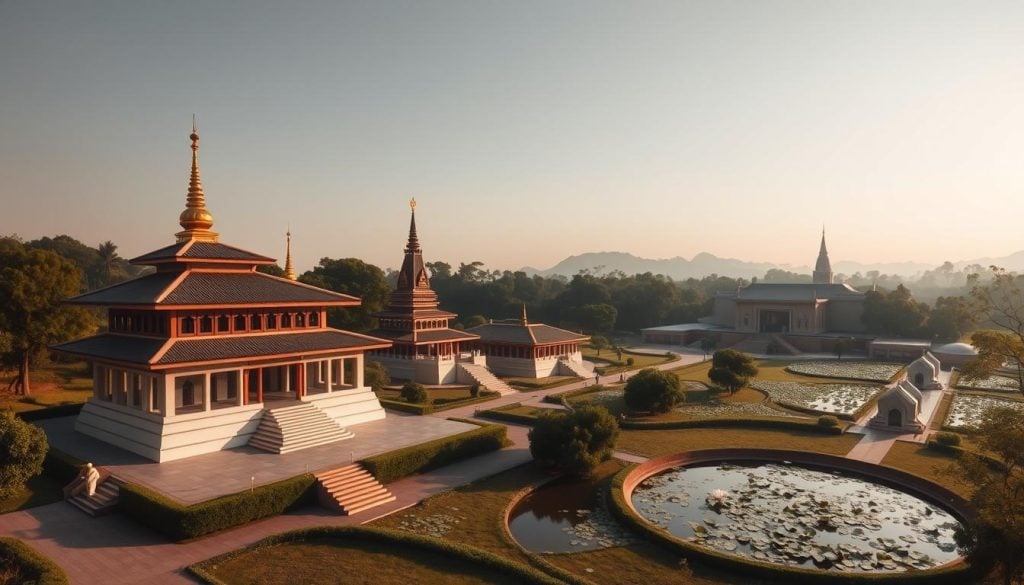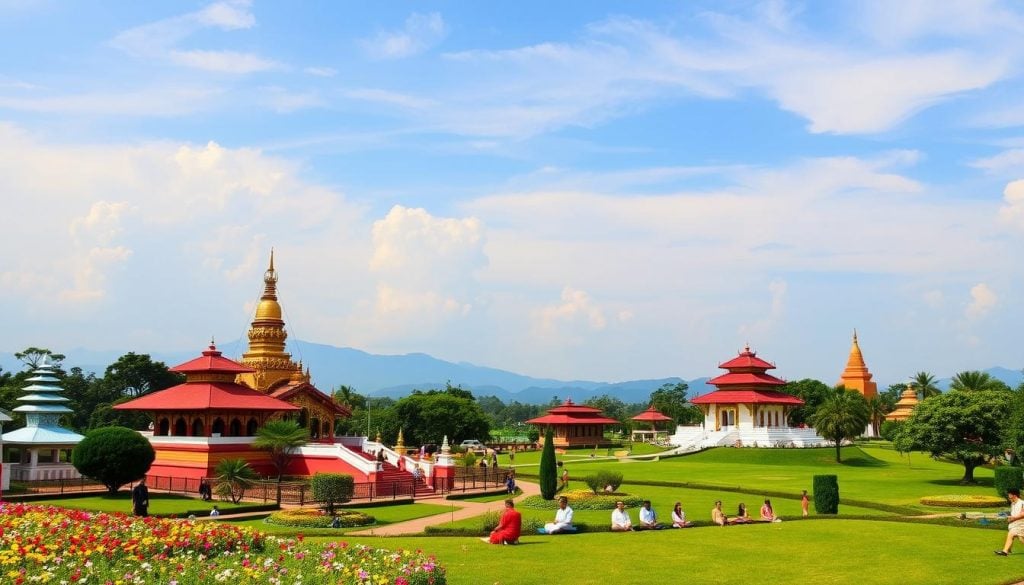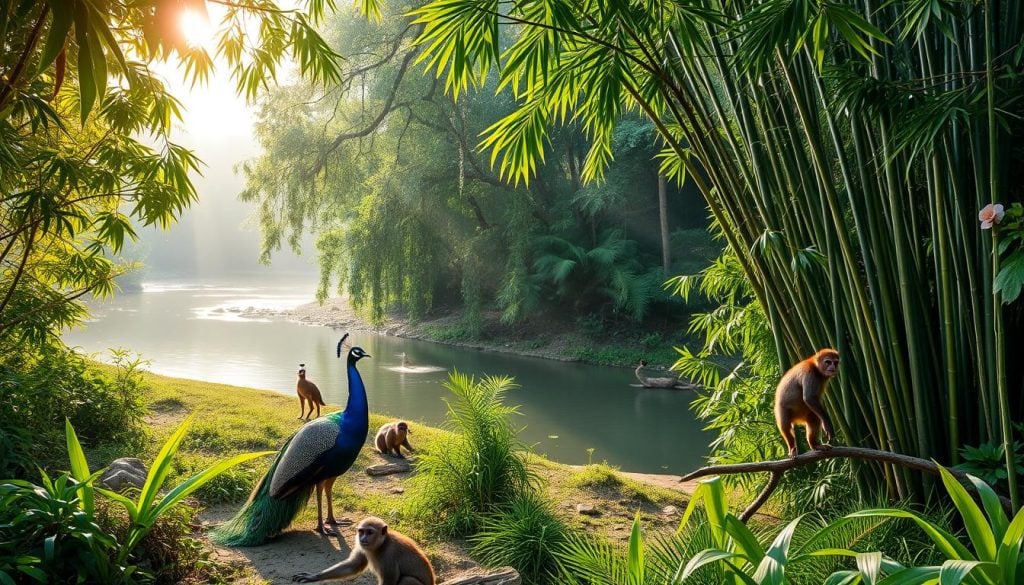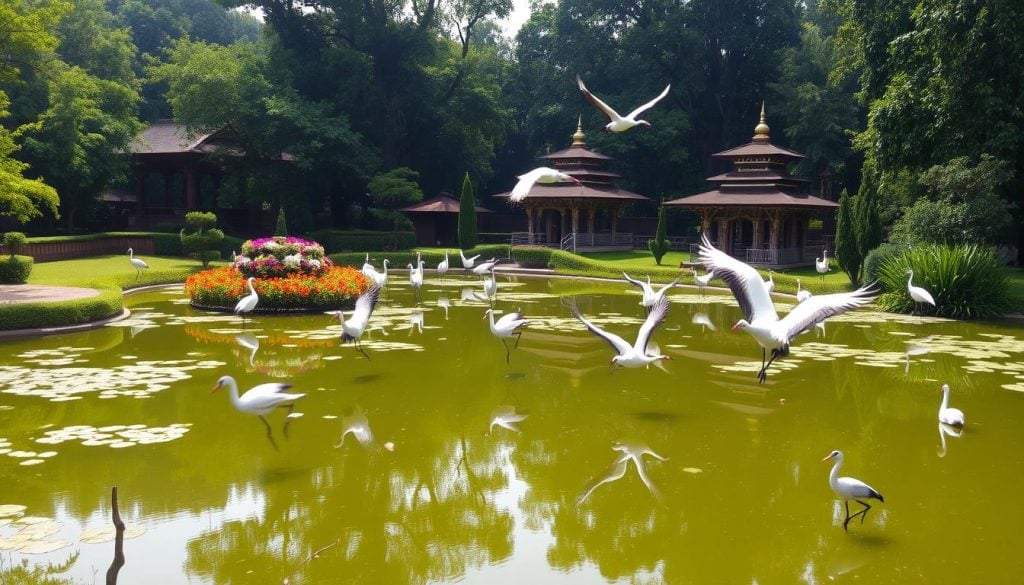Do you think of Lumbini just as the Maya Devi Temple? There’s so much more to this Buddhist pilgrimage site. Lumbini, as a UNESCO World Heritage Site and the birthplace of Lord Buddha, is home to many monasteries. Each one has its own unique style and spiritual meaning.
Let’s explore the rich monastic life of Lumbini together. We’ll uncover sacred spaces and cultural treasures. These invite you to reflect on your own spiritual path.
The Spiritual Significance of Lumbini
Lumbini is a place of deep spiritual meaning for millions. It is known as the birthplace of Buddha. Here, people from all over the world come to start a spiritual journey.
They can learn from Buddha’s teachings. This helps them understand Buddhism better.
Buddha’s Birthplace as a Pilgrimage Site
The Maya Devi Temple marks where Buddha was born. It’s a key spot for many visitors. The Marker Stone, set by Emperor Ashoka, adds to its historical and spiritual value.
Exploring Lumbini, you feel a deep sense of peace. It’s a place where purpose and calm meet.
Connection to Buddhism’s Origins
Lumbini is a special link to Buddhism’s start. It reminds us of Buddha’s early days and teachings. For those practicing spirituality, it’s a chance to connect with a philosophy of compassion and understanding.
Lumbini Monasteries Beyond Maya Devi Temple
Lumbini is a UNESCO World Heritage Site with many monasteries. These monasteries show how Buddhism has spread through architecture. As you visit these sites, you’ll see different architectural styles. Each style reflects the culture of the country it comes from.
A Diverse Range of Architectural Styles
The Lumbini monasteries beyond Maya Devi Temple have over 30 unique structures. Each one shows a different architectural style. This shows how different cultures see Buddhist values.
- The Peace Pagoda, celebrated for its serene beauty.
- The Drigung Kagyud Lotus Stupa from Germany, showcasing intricate designs.
- A Cambodian temple currently under construction, reflecting ongoing dedication to Buddhist traditions.
These monasteries are in two zones. This lets visitors see how Buddhism is seen in different cultures. The unfinished or abandoned structures add to the history of these sites.
Exploring Monasteries of Different Countries
Visiting monasteries built by different countries lets you see their cultures. You’ll see how Buddhism is seen in Lumbini through architecture. Each site is not just for worship but also shows a nation’s identity and art.
The Lumbini Master Plan: A Testament to Buddhist Heritage
The Lumbini Master Plan is a masterpiece that blends beauty with spiritual depth. It was designed by Kenzo Tange in 1978. It makes the visitor’s journey more meaningful by highlighting Buddhist heritage.
This plan creates a peaceful place for visitors to think and find enlightenment. It celebrates the teachings of Buddhism.
Overview of Kenzo Tange’s Design
Kenzo Tange’s design is all about unity and purpose. It has different areas for a spiritual walk. The design is not just beautiful but also carries the spirit of Buddhist heritage.
It invites visitors to explore and reflect. The architecture is designed to inspire.
The Layout and Symbolism of the Site
The plan is circular, leading to the Maya Devi Temple at the heart. It shows the journey from worldly life to enlightenment. Natural elements, like a central canal, add to the spiritual feel.
This design shows Kenzo Tange’s dedication to both physical and spiritual beauty. It’s a blend of nature and sacred spaces.
A Journey Through Time: Historical Monuments
Lumbini is a key spot for exploring historical monuments tied to Buddhist history. The area around the Ancient City of Kapilavastu shows the ancient architecture. It gives visitors a special look into Buddha’s life and teachings.
This site is a key Buddhist pilgrimage site. It shares stories of significant events from Buddha’s life. These events shaped his spiritual path.
Discovering the Archeological Sites of Kapilavastu
Exploring Lumbini leads to the archaeological sites of Kapilavastu. These sites are crucial for understanding Buddha’s childhood. The ancient city, believed to be his home, shows its cultural and historical importance.
Significant Events from Buddha’s Life
Visiting the monuments around Lumbini reveals significant events from Buddha’s life. For example, Kudan marks the moment Buddha met his father after enlightenment. Such moments deepen our understanding of Buddha’s teachings and their global impact.
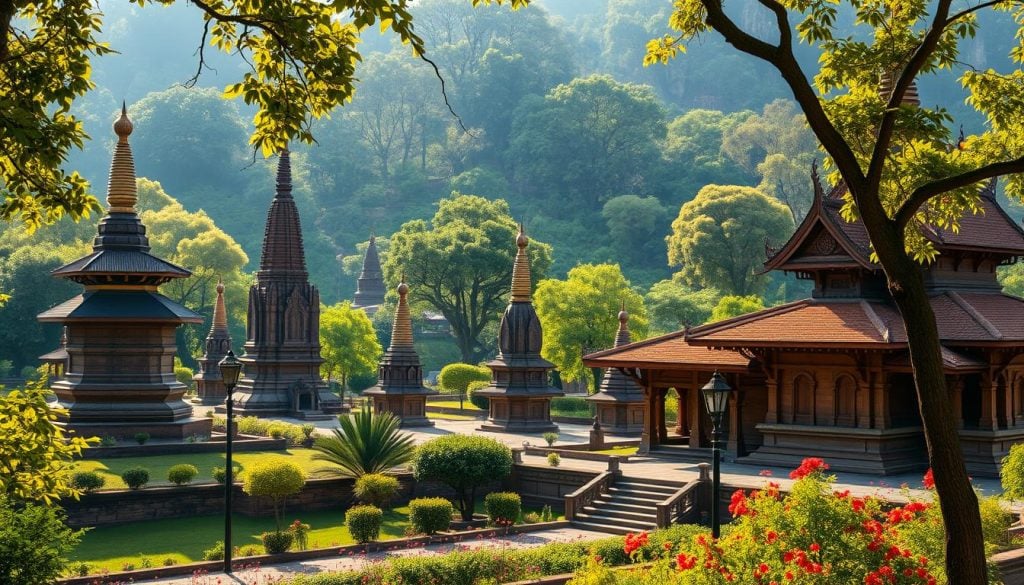
| Site Name | Significance | Location |
|---|---|---|
| Kapilavastu | Buddha’s childhood home | Near Lumbini |
| Kudan | Buddha’s meeting with his father | Close to Kapilavastu |
| Ramagrama Stupa | This stupa is believed to contain Buddha’s relics | Nearby |
| Tilaurakot | Historical site linked to Buddha’s early life | Adjacent to Kapilavastu |
Exploring these historical monuments enriches your visit. It also deepens your respect for Buddhism’s lasting influence on millions today.
Cultural Experiences in Lumbini
Lumbini is a place filled with cultural experiences. You can dive into its rich heritage by connecting with the local Tharu community. This connection helps you understand the importance of religious tourism here.
Tharu Homestays and Traditional Cuisine
Living in Tharu homestays lets you truly experience local customs. You’ll feel the warmth of Tharu hospitality and taste authentic Tharu food. The dishes are made with fresh, local ingredients, making your meal unforgettable. Some must-try dishes include:
- Bhutte ko Jaanza – A corn-based delicacy
- Tharu Saag – Leafy green vegetables cooked with spices
- Pulau – A flavorful rice dish made with aromatic spices
Engaging with Local Customs and Festivals
Joining in local festivals gives you a deeper look into the culture. These celebrations feature vibrant dances and rituals. They show the Tharu people’s beliefs. Some key festivals are:
- Maghi – Celebrating the harvest season
- Holi – Known for its lively colors and joy
- Dussehra – Marking the victory of good over evil
By taking part in these festivals, you connect with the community. This connection helps you understand Lumbini’s heritage better. These experiences make your visit more meaningful.
| Aspect | Details |
|---|---|
| Homestays | Experience authentic Tharu hospitality |
| Cuisine | Enjoy traditional dishes made with local ingredients |
| Festivals | Participate in vibrant celebrations |
| Community Engagement | Learn about local customs and traditions |
Meditation Retreats and Spiritual Practices
Lumbini’s monastic zones offer a peaceful setting for meditation. Both pilgrims and visitors can find calm here, away from daily stress. Many monasteries host meditation retreats. These retreats focus on different spiritual practices to deepen your understanding of Buddhism.
Finding Peace in the Monastic Zones
In these serene spots, you can dive into meditation’s essence. Nature and spiritual vibes create a perfect space for self-reflection. Places like the Korean Monastic Complex and the Thai Monastery offer quiet spots for mindfulness.
Attending these retreats lets you learn from skilled teachers. They guide you through various meditation techniques.
Tips for Engaging in Meditation
Good meditation needs focus and intention. Here are some tips to improve your experience:
- Find a designated quiet area: Pick a spot free from distractions to concentrate better.
- Practice guided sessions: Many monasteries have structured programs to teach different meditation methods.
- Engage with local monks: They share valuable insights and traditional practices that deepen your meditation understanding.
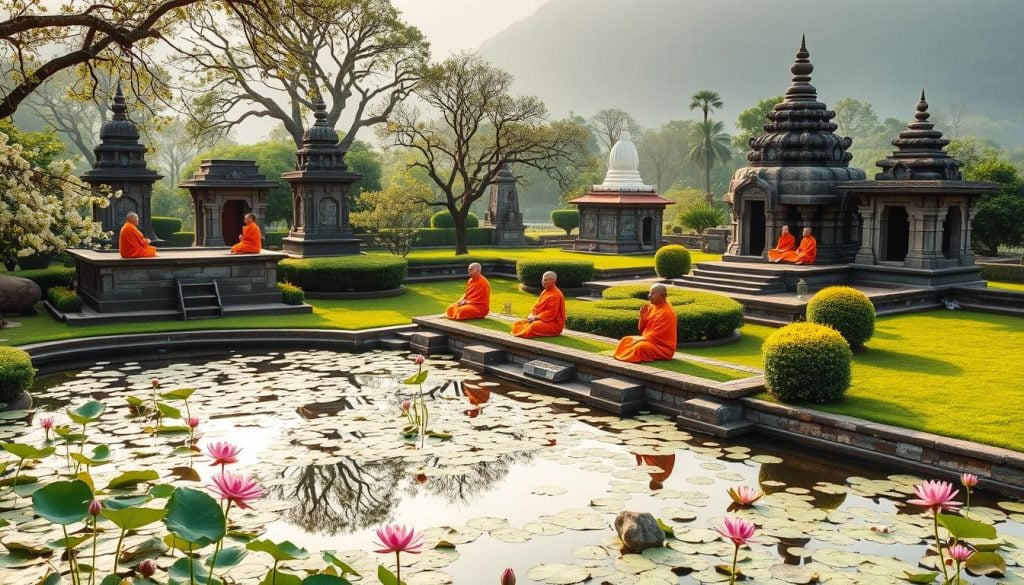
Exploring Surrounding Attractions Near Lumbini
Lumbini is a great place to see nearby attractions. These spots help you understand the history and culture around this important site. The area has many archaeological sites and natural wonders, perfect for history buffs and adventure seekers.
Nearby Historical and Cultural Landmarks
Places like Devdaha, Ramagrama, and Tilaurakot are close to Lumbini. They give us a peek into Buddha’s life and the ancient world he lived in. Visiting these sites makes you appreciate Buddhism’s history and the local culture more.
Natural Beauty and Wildlife Experiences
The natural beauty around Lumbini is stunning. You can visit the Jagdispur Reservoir and the Lumbini Crane Sanctuary. These spots are great for seeing wildlife, especially birds. Here, you can see many bird species and enjoy Nepal’s plants and animals.
Exploring these attractions makes your trip rewarding. You get to enjoy nature and learn about history, making your journey unforgettable.
The Environmental Significance of Lumbini
Lumbini is very important for the environment, especially with its crane sanctuary. It helps protect endangered species like the Sarus Crane. Seeing these birds in their natural home helps us appreciate nature and the balance between it and spirituality.
Conservation Efforts in the Crane Sanctuary
The crane sanctuary has vital wetlands that help restore natural habitats. This shows the importance of compassion, as taught in Buddhism. Visitors can help protect these birds and their homes by joining in conservation efforts.
- Participate in educational programs designed to raise awareness about local wildlife protection.
- Experience the serenity of the sanctuary while observing the diverse bird population.
- Support initiatives that enhance habitat restoration and promote eco-friendly practices.
Conclusion
Exploring Lumbini’s monasteries beyond Maya Devi Temple gives you a rich view of Buddhist heritage. It’s a key Buddhist pilgrimage site, offering a mix of architectural styles, spiritual practices, and cultural experiences. Each monastery shows a unique influence, adding to Buddhism’s vast history and philosophy.
Your trip to Lumbini is a deep spiritual journey. It reveals the teachings of Buddha that have touched millions of lives. It’s not just visiting old sites; it’s a chance to understand Buddha’s life and the values of compassion, mindfulness, and peace.
Visiting Lumbini is truly transformative. It lets you connect with Buddhism’s roots. Walking through peaceful landscapes and meeting the community, you’ll find inspiration and insight that lasts long after you leave.

































